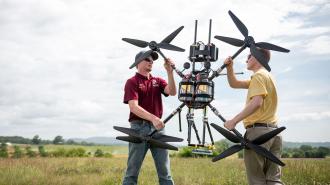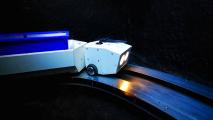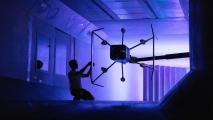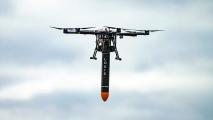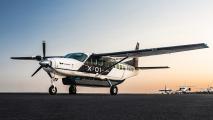To an outsider’s eyes, what’s happening in the skies over Blacksburg, Virginia, looks like a budding disaster. Two drones whine through the air, headed at each other — and at the same altitude. A head-on collision is imminent.
One resembles a Jetsons’ take on an airliner, all long white wings and a fuselage the color of a space shuttle fuel tank — appropriate, for a NASA-operated Tempest drone. The other is a quadcopter, that classic drone with four propellers, but it’s carrying something unique: a box that looks like a router.
That box is key to solving one of the most vexing issues of drone flight.
The FAA requires all vehicles in the sky to be able to see and avoid other vehicles. A piloted aircraft does this literally with the pilot’s eyes, with technology like radar, and via air traffic control. Drones, by definition, lack the former, and the latter two just aren’t very practical — yet.
It’s a problem.
See and Avoid: Drone Regulations’ Big Hurdle
To meet the “see and avoid” mandate, FAA drone regulations require that drones be flown within visual line of sight. Basically, you have to see it to fly it. This limits how far a drone can fly, which in turn limits what it can do. If an Amazon employee has to see their drone the whole time to deliver your package, it doesn’t make much sense to use a drone.
“My own gut feel,” says John Coggin, “is that 98% of the economic potential of UAS (unmanned aircraft systems) will not be realized until detect-and-avoid solutions are robust.”
Coggin is the chief engineer at Virginia Tech’s Mid-Atlantic Aviation Partnership (MAAP), working with NASA to develop detect-and-avoid ability for drones. The drones flying head-on over Virginia are part of MAAP’s project.
“The two things that make it difficult is you have to be able to detect both the cooperative and the non-cooperative traffic,” says Kristy Kiernan, an associate professor in the College of Aeronautics at Embry-Riddle. “And also you’re talking about a range of objects you need to detect, from the very small to the very large.”
“Cooperative traffic” is broadcasting a signal at all times, making it easier to avoid; MAAP focuses on the non-cooperative, the vehicles that are not announcing their presence. And those vehicles all look different on radar, sound different, and move in different ways.
To top it all off, whatever system you build, it will need to be incredibly reliable — drone regulations are as stringent as those for any other aircraft.
It’s perhaps the most daunting challenge in the FAA’s drone rules.
Without a pair of eyes in the cockpit, detection is the first step. There are three leading candidates for sensing “intruders” into a drone’s airspace, Coggin says: radar, auditory sensors, and computer vision. All have their advantages and drawbacks.
“98% of the economic potential of UAS (unmanned aircraft systems) will not be realized until detect-and-avoid solutions are robust.”
John Coggin Chief Engineer at Virginia Tech’s Mid-Atlantic Aviation Partnership (MAAP)
Auditory sensors will need to be able to ignore sounds that don’t matter — like their own drone’s engines — and pick out the ones that do. Computer vision will have the difficult task of seeing and modeling a wide variety of shapes from any vector, and it would need pretty high-end cameras for maximum effectiveness.
Radar units are heavy, expensive, and need to be fine-tuned to make sure the drone is seeing what it wants and needs to see — which is not going to always be everything in the air. And whatever sensor or suite of sensors a drone uses, it needs to be cost effective and light.
“One of the big challenges is to expand the capability of the sensors while maintaining low cost and low weight,” Coggin says.
The MAAP drone whirring over the Virginia hillside is carrying a tuned up Echodyne radar box to fulfill the “detect” part of detect-and-avoid. But even with eyes in place, it also needed a brain.
Bob and Weave
Detecting an intruder into a drone’s airspace is only half the battle, of course. The drone must have the ability to safely get out of the way and resume its flight. To achieve this, MAAP used a NASA program named (perhaps ill-advisedly) ICAROUS.
ICAROUS is a software platform that can be used to deploy specific programs for drones. The software suite used at Virginia Tech told the drone to evade intruders in its airspace and maintain a safe buffer zone.
“The primary ingredient (of the ICAROUS algorithm) is the position of the target aircraft for all the targets around it,” says NASA’s Lou Glaab, a principle investigator for the project.
Armed with that information, the drone can predict where a possible collision would take place, and maneuver to avoid it.
The researchers assume that the intruder will never be aware of the drone, Coggin says. The onus is on the drone to keep out of the way. And because it has no pilot, it can take riskier moves to avoid oncoming traffic — like flying low, out of the way of most intruders but dangerous for a human being.
Drones with robust enough detect-and-avoid systems that they can fly safely through any kind of airspace are likely years away, Glaab says. Balancing what the sensors will require, how large and power hungry they are, and their cost makes it all a tricky task.
Dodging Drones
Back above the Blacksburg hills, the two drones are still playing chicken, flying along their preprogrammed flight paths.
Just as a collision begins to look imminent, the quadcopter dodges the Tempest. Independently and autonomously, the quadcopter’s radar and algorithm see the intruding Tempest and avoid it.
“The first time you do it, nerves are high when you don’t know what each vehicle — or both vehicles — are going to really do,” says Glaab.
Using the MAAP-developed system, the quadcopter successfully evaded not only NASA’s drone but also a Cessna flown by pilots from Liberty University. The manned aircraft and drone were never at the same altitude, however — safety first. Similarly, both drones, while flying autonomously, could be taken over by a pilot on the ground if things went awry.
Seeing the successful evasion left an impression on Coggin, who relayed his reaction to Virginia Tech Daily.
“This was one of the most exciting moments I’ve experienced at the test site, to witness an autonomous system replace what the pilot does when it comes to sense and avoid.”
